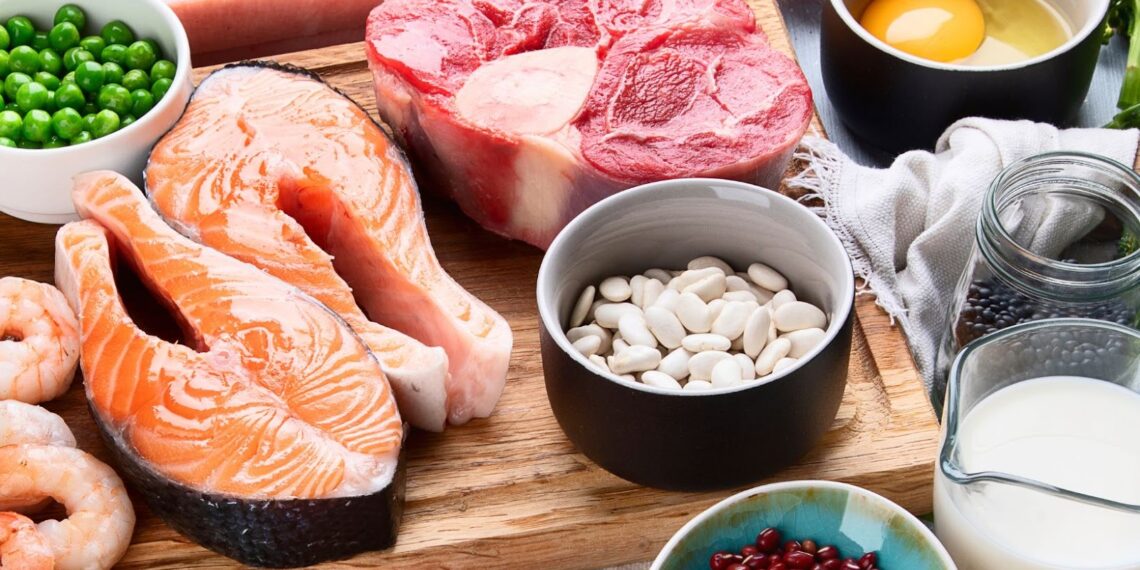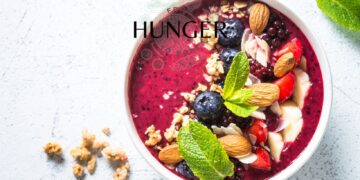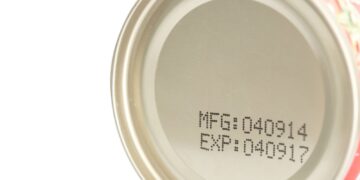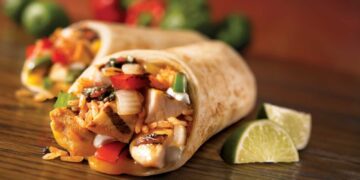When trying to hit your protein goals, plenty of food options can help you reach your desired intake. These foods are high in protein and delicious and easy to incorporate into your diet.
Here are some foods to eat when trying to hit your protein goals:
Eggs: Whole eggs are an excellent source of protein, vitamins, and minerals.
Greek Yogurt: Greek yogurt is high in protein and low in fat, making it an ideal snack or breakfast option.
Chicken Breast: Chicken breast is a staple protein source, easy to cook, and versatile in meals.
Lentils: Lentils are an inexpensive, plant-based source of protein, high in fiber, and low in fat.
Fish: Fish, such as salmon or tuna, are an excellent omega-3 fatty acids and protein source.
Quinoa: Quinoa is a gluten-free, plant-based source of protein, high in fiber, and essential minerals.
Incorporating these foods into your meals can help you hit your protein goals and maintain a healthy lifestyle.
High-Protein Meats
When trying to hit your protein goals, including high-protein meats in your diet is important. These meats provide a good source of quality protein for your body and can help you reach your daily protein intake. High-protein meats include lean beef, chicken, turkey, pork, lamb, and fish.
In this article, look at these meats and their associated nutrition facts.
Lean Beef
Lean beef is an excellent high-protein choice for anyone looking to meet their protein goals and maintain a healthy diet. A 3.5-ounce serving of lean beef typically contains around 25 grams of protein and is a great source of iron, zinc, and vitamin B12.
Other high-protein meats and foods to consider include:
Chicken breast:
A 3.5-ounce serving of chicken breast contains around 31 grams of protein and is low in fat.
Turkey: Turkey is another lean, high-protein option, with around 30 grams of protein in a 3.5-ounce serving.
Fish: Many types of fish, including salmon, tuna, and halibut, are rich in protein, omega-3 fatty acids, and other nutrients.
Eggs: One large egg contains around 6 grams of protein and is a great source of healthy fats and vitamins.
Lentils: Lentils are a plant-based source of protein, fiber, and essential nutrients. A half-cup of cooked lentils contains around 9 grams of protein.
High-protein foods can help maintain muscle mass, promote satiety, and support overall health and wellness.
Chicken Breast
Chicken breast is a highly popular high protein food item, perfect for those aiming to meet their daily protein goals.
Chicken breast is an excellent source of lean protein, which helps build and repair muscles, regulate hormones, and maintain healthy skin, hair, and nails. Moreover, it is low in calories, making it an ideal choice for people trying to maintain a healthy weight.
Here are some simple ways to incorporate chicken breast into your diet:
Grilling or baking chicken breast and pairing it with your favorite vegetables or healthy sides.
Adding chicken breast to your salads, wraps, or sandwiches.
Stir-frying chicken breast with vegetables and herbs for a healthy meal.
Pro-tip: To ensure you meet your protein goals, aim for consuming 0.8-1 grams of protein per pound of bodyweight daily.
Turkey Breast
Turkey breast is a high-protein meat that is an excellent addition to your diet to hit your protein goals. Turkey breast contains up to 30 grams of protein per 100-gram serving and is a lean meat, meaning it is relatively low in fat and calories.
Other high-protein meats to consider include:
Chicken breast: Chicken breast contains up to 31 grams of protein per 100-gram serving.
Beef: Beef is a good source of protein, with a 100-gram serving of steak containing up to 26 grams of protein.
Fish: Fish is a rich source of protein, with salmon, tuna, and tilapia containing up to 22 grams of protein per 100-gram serving.
Adding high-protein meats to your diet can help with muscle recovery, weight management, and overall health.
Pro tip: Pair high-protein meats with complex carbohydrates and healthy fats for a balanced and nutritious meal.

Seafood
Seafood is an excellent source of lean protein, making it an ideal choice when trying to hit your protein goals. Seafood also contains Omega-3 fatty acids, which are beneficial for overall health. Eating fish, shrimp, and other seafood can help you meet your daily protein intake without too many calories or saturated fat.
Look at some of the best seafood choices for hitting your protein goals.
Salmon
Salmon is a delicious and protein-rich seafood option to include in your diet to hit your protein goals. One 3-ounce serving of salmon contains around 22 grams of protein, nearly half the daily recommended intake for an average adult.
Some delicious and healthy ways to prepare salmon include grilled, baked, poached, or smoked, depending on your preferences. Additionally, salmon is a rich source of omega-3 fatty acids, which provide numerous health benefits, including reducing inflammation and improving heart and brain health.
Other high-protein seafood options include tuna, shrimp, crab, and cod.
Tuna
Tuna is an excellent seafood choice to meet your protein goals. Tuna is a lean protein source high in omega-3 fatty acids, essential for heart health and brain function. A 3-ounce serving of canned tuna contains up to 20 grams of protein with minimal fat and no carbs, making it an ideal food to include in your high protein diet.
You can consume tuna in various ways:
1. Tuna salad: Mix canned tuna with olive oil, lemon juice, herbs, and spices for a simple and delicious salad.
2. Tuna sushi: Wrap raw tuna in sticky rice and nori for a high-protein sushi roll.
3. Tuna steak: Grill or pan-fry a tuna steak and season with salt, pepper, and lemon juice.
You can meet your protein goals by incorporating tuna into your diet while enjoying a delicious and nutritious seafood meal.
Shrimp
Shrimp is a delicious seafood option when trying to hit your protein goals. Shrimp is an excellent source of protein, low in calories, and contains many important vitamins and minerals. A single 3 oz serving of shrimp contains about 18 grams of protein and only 84 calories.
Additionally, shrimp is a rich source of selenium, vitamin B12, phosphorus, and choline. Selenium helps to support a healthy immune system and may reduce the risk of chronic diseases. Vitamin B12 is essential for proper nerve function and blood formation. Phosphorus is important for healthy bones and teeth, and choline plays a key role in brain development and function.
Shrimp is a versatile ingredient that can be grilled, baked, sautéed, or boiled, making it an easy addition to any meal. Pro tip: To maximize the nutritional benefits of shrimp, try pairing it with fresh vegetables and whole grains for a balanced and healthy meal.
Dairy Products
Dairy products are an excellent source of protein and should be included in your diet if you’re trying to hit your protein goals. Common dairy products, such as milk, cheese, and yogurt, are packed with protein, vitamins, minerals, and probiotics to help support your health.
This section will discuss the various types of dairy products and how they can help you reach your protein goals.
Greek Yogurt
Greek yogurt is an excellent option for those looking to reach their protein goals through their diet. One serving of Greek yogurt can contain up to 17 grams of protein, making it an ideal snack or breakfast food.
Greek yogurt is also low in calories and fat, making it a healthier alternative to traditional yogurt or other protein sources like bacon or sausage. Also, Greek yogurt is high in calcium, which is important for bone health.
When selecting Greek yogurt, opt for plain, non-fat or low-fat varieties with no added sugars, and consider adding fresh fruit or honey for flavor. Greek yogurt can be consumed independently, used as a substitute for sour cream in recipes, or added to smoothies and shakes for an extra protein boost.
Cottage Cheese
Cottage cheese is a fresh cheese made from the curds of cow’s milk. It is a versatile dairy product that can be consumed independently or used in various recipes.
Here are some of the benefits of consuming cottage cheese:
High in protein
Cottage cheese is an excellent source of protein, with one cup containing about 25 grams.
Low in calories: A cup of cottage cheese typically contains fewer than 200 calories and is a good option for those looking to manage their weight.
Low in fat: Cottage cheese is lower in fat than many other types of cheese, making it a good option for those looking to reduce their fat intake.
Good for bone health: Cottage cheese is a good source of calcium, which is important for maintaining strong and healthy bones.
Versatile: Cottage cheese can be eaten on its own or used in various recipes, from savory dishes like lasagna to sweet treats like cheesecake.
Pro tip: Add cottage cheese to your smoothies for an extra boost of protein and creaminess.
Milk
Milk is a delicious and refreshing beverage and a great source of protein that can help you meet your daily protein goals when trying to build muscle or lose weight.
One cup of milk (240 ml) contains around 8 grams of high-quality protein, which contains all essential amino acids our body needs to function properly.
Greek Yogurt
17
Cottage Cheese
14
Cheese
7
Other dairy products that are rich in protein include Greek yogurt, cottage cheese, and cheese. These are also nutrient-dense and low in calories, making them an ideal source of protein for those on a weight loss journey.
Incorporating milk and other dairy products into your diet can help you meet your daily protein needs while providing other essential vitamins and minerals to support overall health.
However, it’s important to be mindful of dairy allergies or lactose intolerance when consuming these foods. Opting for lactose-free and plant-based alternatives can be a good option for those who cannot consume traditional dairy products.

Plant-Based Protein Sources
Achieving your protein goals while following a plant-based diet can be challenging, but it doesn’t have to be impossible. Plant-based foods can provide essential protein and offer a variety of nutritional benefits. In this article, we’ll cover the plant-based protein sources you can use to hit your protein goals.
Lentils
Lentils are an excellent source of plant-based protein that can help you meet your daily protein goals. One cup of cooked lentils contains about 18 grams of protein, making it an effective substitute for meat-based protein sources.
Here are some tips to help you incorporate lentils into your diet:
Replace meat in your favorite soup or stew recipe with lentils for a hearty and protein-packed meal.
Add cooked lentils to salads for a protein boost.
Make lentil patties by combining cooked lentils, onions, garlic, and spices, then pan-frying until golden brown.
Use lentil flour in baked goods for a protein-rich twist on your favorite recipes.
Combine lentils with foods high in vitamin C, such as tomatoes or citrus fruit for optimal nutrient absorption.
Incorporating lentils into your diet can help you reach your protein goals while reaping this versatile legume’s many nutritional benefits.
Chickpeas
Chickpeas are an excellent plant-based protein source and a great addition to your diet when trying to hit your protein goals.
Here’s why:
A 1-cup serving of chickpeas contains about 15 grams of protein, making it a great protein source for vegetarians and vegans.
Chickpeas are also a good source of fiber, which helps you stay satiated and can aid in weight loss.
They’re also rich in vitamins and minerals like folate, iron, and phosphorus, essential for overall health.
Chickpeas are incredibly versatile and can be used in various dishes, from salads to curries to roasted snacks.
So chickpeas are a great place to start if you’re looking to increase your protein intake with a plant-based source!
Tofu
Tofu is one of the best plant-based protein sources for your diet to hit your protein goals. One serving of tofu (3.5 ounces) contains approximately 8 grams of protein, making it an excellent source of plant-based protein for vegans and vegetarians.
Here are some ways to incorporate tofu into your diet:
Tofu scramble:
Use crumbled tofu in place of scrambled eggs to make a protein-packed breakfast.
Tofu stir-fry:
Add cubed tofu to your favorite stir-fry recipe for a protein boost.
Tofu burger:
Make a delicious and healthy veggie burger with mashed tofu instead of meat.
Tofu salad:
Add cubed tofu to your salad for a satisfying and protein-rich meal.
Tofu smoothie:
Blend silken tofu with your favorite fruits and veggies for a creamy, protein-packed smoothie.
Pro tip: Choose organic and non-GMO tofu to avoid genetically modified soybeans and pesticides.
Protein In 100g Chicken Breast Cooked
Once you’ve focused on increasing your protein intake, you’ll need some nutritious protein-rich vegetables to help you reach your goals. Eating various protein-rich vegetables can effectively hit your protein goals while also providing essential nutrients and important dietary fiber.
Let’s look at some of the best protein-rich vegetables you should include in your diet.
Peas
Peas are a great protein-rich vegetable for your diet to hit your protein goals.
Food Source
Protein per cup
Peas
8g protein
Milk
8g protein
Ground beef
26g protein
Chicken breast
43g protein
Here are some ways to incorporate peas into your protein-rich meal plan:
- Add peas to your salads, soups, and stews for an extra boost of protein and fiber.
- Use pea protein powder in your smoothies or baking recipes.
- Make a dip or spread using peas, such as hummus or guacamole.
- Roast peas in the oven with some seasoning and enjoy them as a crunchy snack.
Pro tip: Combine peas with other plant-based protein sources like quinoa, lentils, and nuts for a complete amino acid profile.
Edamame
This vegetable is rich in protein and offers various health benefits, making it an excellent choice for people trying to hit their protein goals.
Edamame, or soybeans, provides a complete protein profile containing all nine essential amino acids necessary for optimal bodily functions.
Half a cup of edamame contains up to 11 grams of protein, making it ideal for people with high protein needs such as athletes, bodybuilders, or those trying to gain muscle mass.
Additionally, edamame is a rich source of other nutrients such as fiber, iron, magnesium, and potassium, and has been linked to reducing cholesterol levels and the risk of heart disease.
Edamame can be consumed as a snack, side dish, or added to salads and soups, making it a versatile and nutritious addition to any meal plan.
Broccoli
Broccoli is a protein-rich vegetable that can help you achieve your protein goals when incorporated into your diet. One cup of chopped broccoli contains:
- 2.6 grams of protein.
- Making it a great option for vegetarians.
- Vegans.
- Anyone looking to increase protein intake while consuming nutrient-dense foods.
Besides protein, broccoli is also a rich source of fiber, vitamins, and minerals necessary for maintaining good health.
Here are some ways to utilize broccoli in your daily meals:
Add chopped broccoli to your stir-fries, soups, or salads.
Roast broccoli with olive oil and your choice of seasonings for a crunchy and delicious snack or side dish.
Blend broccoli into a smoothie with protein-rich ingredients like nut butter or protein powder.
Broccoli could be a delicious and healthy addition to your balanced diet, that can help you achieve your protein goals alongside other essential nutrients.
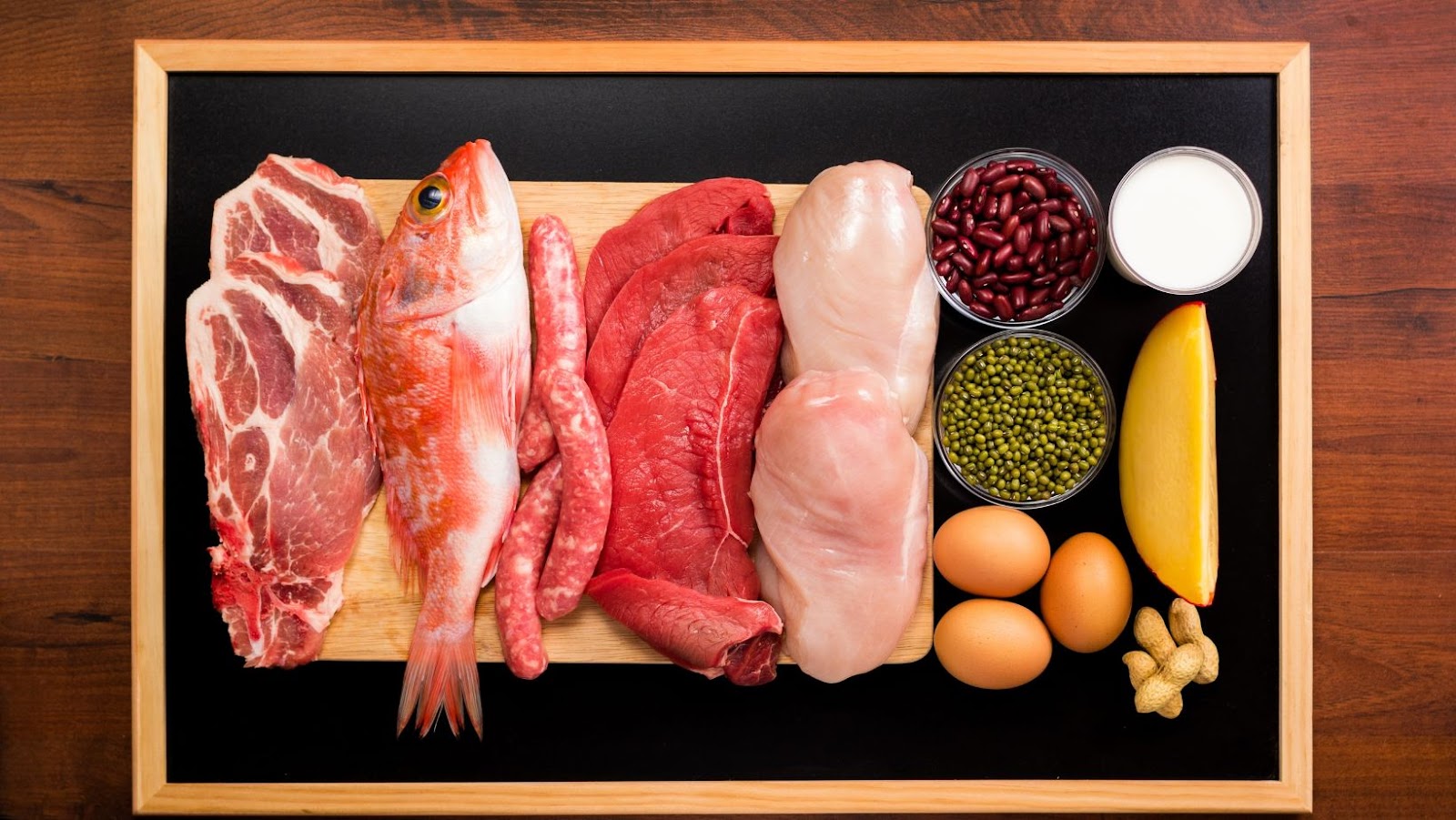
Protein Bars and Shakes
When hitting your protein goals, protein bars and shakes can be a great choice. Not only are they convenient and easy to take on the go, but they are also a great way to get the protein your body needs. In addition, they typically come in various flavors, so you can find one you enjoy.
Let’s explore different types of protein bars and shakes as we explore foods to eat when trying to hit your protein goals.
Whey Protein Powder
Whey protein powder is an excellent way to supplement your protein intake, particularly if you struggle to meet your daily protein goals through whole foods.
Here are some ways to incorporate whey protein powder into your diet as protein bars and shakes:
Protein Bars:
(i) Mix whey protein powder with oats, nut butter, and dried fruit to create a protein-packed snack.
(ii) Refrigerate the mixture for 30 minutes, cut into bars, and store in the fridge for up to a week.
Protein Shakes:
(i) Mix whey protein powder with milk or water, and blend with frozen fruit and ice.
(ii) Blend with Greek yogurt or nut milk for a creamier shake.
(iii) Add spinach or kale to make a nutrient-packed green smoothie.
Incorporating whey protein powder into your diet can help you reach your protein goals easily while providing various other health benefits.
Plant-Based Protein Powder
Plant-based protein powder is an excellent option for people looking to increase their protein intake or replace animal-based protein powders in their diet.
Here are some of the benefits of using plant-based protein powder:
- Vegan-friendly: Plant-based protein powders are ideal for individuals following a vegan or vegetarian lifestyle.
- Gluten-Free: Plant-based protein powders are often gluten-free, unlike many animal-based protein powders.
- Easy to Digest: Plant-based protein powders are easily digestible and less likely to cause bloating or gastrointestinal discomfort.
When trying to hit your protein goals, some foods include quinoa, lentils, chickpeas, hemp seeds, chia seeds, tofu, nuts, and nut butter. Pro Tip: Mix plant-based protein powder into your favorite smoothie or create protein bars for a tasty and convenient snack.
High-Protein Bars
High-protein bars can be a convenient and tasty way to meet your daily protein requirements, especially when trying to hit your protein goals.
When selecting a high-protein bar, look for bars containing at least 15 grams of protein per serving and a moderate amount of healthy fats and fiber to keep you full and satisfied.
Some of the best high-protein bars include:
Bar
Protein per serving
Quest Bars
20 grams
KIND Protein Bars
12 grams
RX Bars
12 grams
Whether on the go or need a quick post-workout snack, high-protein bars can be a great option.
However, it’s important to remember that whole food sources of protein should make up the bulk of your protein intake.


